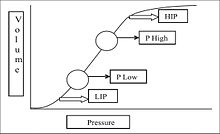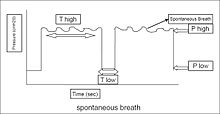Airway pressure release ventilation

Airway pressure release ventilation (APRV) is a
History


Airway pressure release ventilation was described initially by Stock and Downs in 1987[2][3] as a continuous positive airway pressure (CPAP) with an intermittent release phase. APRV begins at a pressure higher than the baseline pressure and follows with a deflation to accomplish tidal ventilation.[4] Fundamentally APRV is a time-cycled alternant between two levels of positive airway pressure, with the main time on the high level and a brief expiratory release to facilitate ventilation.[5]
Indications
Based on clinical and experimental data, airway pressure release ventilation is indicated in patients with
after major surgeryInverse ratio ventilation
This is a type of inverse ratio ventilation.[9] The exhalation time (Tlow) is shortened to usually less than one second to maintain alveoli inflation. Fundamentally this is a continuous pressure with a brief release. APRV is currently the most efficient, conventional mode for lung protective ventilation.[10][11][12]
Settings and measurements

Settings are sometimes brand specific and the term for the individual settings may differ, however generally the settings listed here are a fundamental explanation of the purpose of the settings within the APRV mode.
- Phigh — This is the inspiratory pressure (just like in pressure control).
- Thigh — This value is the number of seconds during the inhalation phase.
- Tpeep — Also known as the Tlow, this is the time allotted for expiration.
- FiO2 — The fractional O2 percentage of the delivered air-and-oxygen mixture.
Mean airway pressure
Mean airway pressure on APRV is calculated by this formula:[1]
Perceptions and receptions
Different perceptions of this mode may exist around the globe. While 'APRV' is common to users in
Other terms
APRV is used by many brands and models of mechanical ventilators under different names. Most names are copyrighted as trademarks and do not represent nomenclature of mechanical ventilation but may be referred to clinically by the brand name.[citation needed]
Some of these names include:
- BiVent - (Servo-i ventilator by Maquet)
- BiLevel - (Puritan Bennett 840 ventilator by Covidien, Flight-60 ventilator by Flight Medical)
- DuoPAP - ( C-1 ventilator by Hamilton)
References
- ^ PMID 19727373.
- PMID 3568710.
- PMID 3552443.
- PMID 11759551.
- PMID 21345265.
- PMID 16236977.
- S2CID 11429381.
- ^ PMID 10194172.
- ^ PMID 11511336.
- PMID 21742214.
- PMID 8004312.
- S2CID 3175012.
- PMID 2686487.
- PMID 11435237.
- S2CID 4679990.
- ^ Kenny, JE (May 2018). "ICU Physiology in 1000 Words: Airway Pressure Release Ventilation – Part 3". PulmCCM.
Daoud EG, Farag HL, Chatburn RL (2012). "Airway pressure release ventilation: what do we know?". Respir Care. 57 (2): 282–92.

